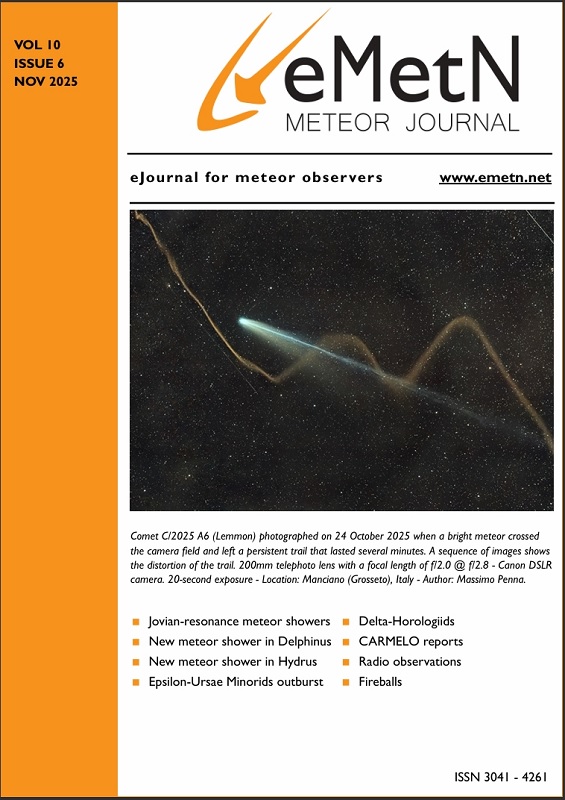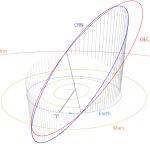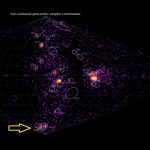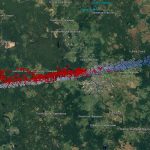During this period, the moon reaches its last quarter phase on Wednesday June 18th. At that time the half-illuminated moon will be located 90 degrees west of the sun and will rise near 02:00 local summer time (LST). This weekend the waning gibbous moon will rise during the late evening hours and will remain in the sky for the remainder of the night. Viewing meteor activity during this time will be difficult as the bright moon will obscure all but the brightest meteors. You can try to view between dusk and moon rise but activity at this time is very low. The estimated total hourly rates for evening observers this weekend should be near 1 as seen from mid-northern latitudes (45N) and 2 as seen from tropical southern locations (25S). For morning observers, the estimated total hourly rates should be near 4 as seen from mid-northern latitudes (45N) and 8 as seen from tropical southern locations (25S). Morning rates are reduced during this period due to lunar interference. The actual rates seen will also depend on factors such as personal light and motion perception, local weather conditions, alertness, and experience in watching meteor activity. Note that the hourly rates listed below are estimates as viewed from dark sky sites away from urban light sources. Observers viewing from urban areas will see less activity as only the brighter meteors will be visible from such locations.
The radiant (the area of the sky where meteors appear to shoot from) positions and rates listed below are exact for Saturday night/Sunday morning June 14/15. These positions do not change greatly day to day so the listed positions may be used during this entire period. Most star atlases (available online and at bookstores and planetariums) will provide maps with grid lines of the celestial coordinates so that you may find out exactly where these positions are located in the sky. I have also included charts of the sky that display the radiant positions for evening, midnight, and morning. The center of each chart is the sky directly overhead at the appropriate hour. These charts are oriented for facing south but can be used for any direction by rotating the charts to the desired direction. A planisphere or computer planetarium program is also useful in showing the sky at any time of night on any date of the year. Activity from each radiant is best seen when it is positioned highest in the sky (culmination), either due north or south along the meridian, depending on your latitude. Radiants that rise after midnight will not reach their highest point in the sky until daylight. For these radiants, it is best to view them during the last few hours before dawn. It must be remembered that meteor activity is rarely seen at its radiant position. Rather they shoot outwards from the radiant, so it is best to center your field of view so that the radiant lies toward the edge and not the center. Viewing there will allow you to easily trace the path of each meteor back to the radiant (if it is a shower member) or in another direction if it is sporadic. Meteor activity is not seen from radiants that are located far below the horizon. The positions below are listed in a west to east manner in order of right ascension (celestial longitude). The positions listed first are located further west therefore are accessible earlier in the night while those listed further down the list rise later in the night.
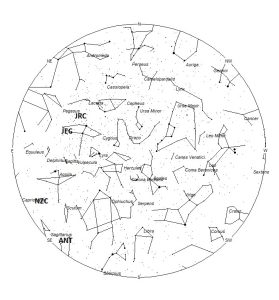
Radiant Position at 23:00 LST
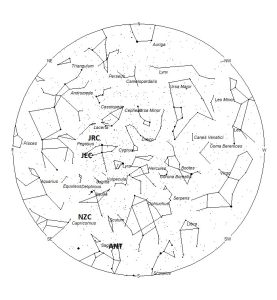
Radiant Position at 01:00 LST
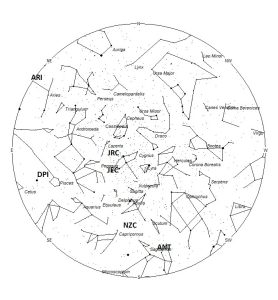
Radiant Position at 03:00 LST
These sources of meteoric activity are expected to be active this week
.
The large Anthelion (ANT) radiant is currently centered at 18:24 (276) -23. This position lies in northern Sagittarius, 2 degrees northwest of the 3rd magnitude star known as Kaus Borealis (lambda Sagittarii). Since this radiant is so large, activity from this source may also appear from Scutum as well as Sagittarius. This radiant is best placed near 02:00 LST when it lies highest in the southern sky. Rates at this time should be less than 1 per hour as seen from the northern hemisphere and 1 per hour as seen from south of the equator. With an entry velocity of 30 km/sec., the average Anthelion meteor would be of medium-slow velocity.
The Northern June Aquilids (NZC) has been known as a weak shower for nearly 100 years. Details on these meteors are quite variable, depending on the source. It is active for at least six weeks with maximum activity occurring around the 1st of July. The current radiant is thought to be active near 19:30 (293) -10. This area of the sky is located in southwestern Aquila, 6 degrees southeast of the 3rd magnitude star known as Al Thalimain (lambda Aquilae). This area of the sky is best placed near 0300 LST when it lies highest in the southern sky. Hourly rates at this time are less than 1 no matter your location. With an entry velocity of 42 km/sec., these meteors would be of medium velocity.
The June epsilon Cygnids (JEC) were discovered by Rudawska and Jenniskens who combined data from SonotaCo net and CAMS in 2014. This weak shower is only active from June 11-15 with maximum occurring on the 13th. At maximum the radiant is located at 21:01 (315) +34. This area of the sky is located in eastern Cygnus, 2 degrees east of the 2nd magnitude star known as Aljanah (epsilon Cygni Aa). The radiant is best placed for viewing during the last hour prior to dawn when it lies highest above the northern horizon in a dark sky. Under the bright conditions during this time, hourly rates would be less than 1 no matter your location. With an entry velocity of 53 km/sec, these meteors would have a medium-fast velocity.
The June rho Cygnids (JRC) were also discovered by Rudawska and Jenniskens who combined data from SonotaCo net and CAMS in 2014. This weak shower is active from June 11-16 with maximum occurring on the 15th. At maximum the radiant is located at 21:23 (321) +45. This area of the sky is located in northeastern Cygnus, 2 degrees southwest of the 4th magnitude star known as rho Cygni. The radiant is best placed for viewing during the last hour prior to dawn when it lies highest above the northern horizon in a dark sky. Under the bright conditions during this time hourly rates would be less than 1 no matter your location. With an entry velocity of 50 km/sec, these meteors would have a medium-fast velocity.
The delta Piscids (DPI) were discovered by Sirko Molau and Juergen Rendtel in 2009, using the IMO’s single station camera system. These meteors are active from June 10-27 with maximum activity occurring on the 22nd. The radiant is currently located at 00:22 (006) +04, which places it in southern Pisces, 4 degrees southeast of the 4th magnitude star known as omega Piscium. The radiant is best placed for viewing during the last hour prior to dawn when it lies highest in the eastern sky prior to dawn. Hourly rates are expected to be less than 1 no matter your location. With an entry velocity of 70 km/sec, these meteors would have a swift velocity.
The last of the Daytime Arietids (ARI) are expected this week from a radiant located at 03:16 (049) +25. This position lies in eastern Aries, 4 degrees southeast of the 4th magnitude star known as 41 Arietis. This position is also approximately 45 degrees west of the sun; therefore these meteors are only visible just before the break of dawn. Face toward the eastern half of the sky to see these meteors shoot upward from the eastern horizon. Hourly rates at this time are expected to be less than 1. With an entry velocity of 42 km/sec., the average meteor from this source would have a medium velocity. This is the strongest daylight shower of the year and radio observers always look forward to the second week of June when it reaches maximum activity.
Sporadic meteors are those meteors that cannot be associated with any known meteor shower. All meteor showers are evolving and disperse over time to the point where they are no longer recognizable. Away from the peaks of the major annual showers, these sporadic meteors make up the bulk of the activity seen each night. As seen from the mid-northern hemisphere (45N) one would expect to see during this period approximately 4 sporadic meteors per hour during the last hour before dawn as seen from rural observing sites. Evening rates would be near 2 per hour. As seen from the tropical southern latitudes (25S), morning rates would be near 7 per hour as seen from rural observing sites and 3 per hour during the evening hours. Locations between these two extremes would see activity between these listed figures. Morning rates are reduced by moonlight.
The list below offers information in tabular form of the active showers that I feel are within reach of the visual observer to discern. Hourly rates are often less than one, so these sources are rarely listed as visual targets in most meteor shower lists. If you are like me and wish to associate as many meteors as possible with known sources, then you will appreciate these listings. Before claiming to have seen meteors from these class IV showers, you should attempt to determine if these meteors actually belong to them and are not chance alignments of sporadic meteors. You can note parameters such as duration, length, radiant distance and the elevation of each meteor to help compute the probability of shower association. It should be remembered that slow meteors can be seen from fast showers, but fast meteors cannot be produced from slow showers. Slower showers are those with velocities less than 35/km per second. Slow meteors can appear from fast showers when they appear close to the radiant or low in the sky. The table located on page 22 of the IMO’s 2025 Meteor Shower Calendar is a big help in aiding in the identification of meteors. If you record the length and duration of each meteor, you can use this chart to check the probability of the meteor belonging to a shower of known velocity. If the angular velocity is similar to the figure in the table, then your meteor probably belongs to that shower. Recognizing meteors from obscure showers is certainly not for the beginning meteor observer as it takes many hours to get a feel of what you are seeing. It is our hope that you will advance beyond watching meteors as a fireworks display and will want to help us expand our knowledge of the heavenly bodies we encounter in the skies above by classifying each meteor you see. Rates and positions in the table are exact for Saturday night/Sunday morning.
| SHOWER | DATE OF MAXIMUM ACTIVITY | CELESTIAL POSITION | ENTRY VELOCITY | CULMINATION | HOURLY RATE | CLASS |
| RA (RA in Deg.) DEC | Km/Sec | Local Summer Time | North-South | |||
| Anthelion (ANT) | – | 18:24 (276) -23 | 30 | 02:00 | <1 -1 | II |
| Northern June Aquilids (NZC) | Jul 03 | 19:30 (293) -10 | 42 | 03:00 | <1 – <1 | IV |
| June epsilon Cygnids (JEC) | Jun 13 | 21:01 (315) +34 | 53 | 05:00 | <1 – <1 | IV |
| June rho Cygnids (JRC) | Jun 15 | 21:23 (321) +45 | 50 | 06:00 | <1 – <1 | IV |
| delta Piscids (DPI) | Jun 22 | 00:22 (006) +04 | 70 | 09:00 | <1 – <1 | IV |
| Daytime Arietids (ARI) | Jun 10 | 03:16 (049) +25 | 42 | 11:00 | <1 – <1 | IV |
You can keep track of the activity of these meteor showers as well as those beyond the limits of visual observing by visiting the NASA Meteor Shower Portal. You can move the sky globe to see different areas of the sky. Colored dots indicate shower meteors while white dots indicate sporadic (random) activity. The large orange disk indicates the position of the sun so little activity will be seen in that area of the sky.
Class Explanation: A scale to group meteor showers by their intensity:
- Class I: the strongest annual showers with Zenith Hourly Rates normally ten or better.
- Class II: reliable minor showers with ZHR’s normally two to ten.
- Class III: showers that do not provide annual activity. These showers are rarely active yet have the potential to produce a major display on occasion.
- Class IV: weak minor showers with ZHR’s rarely exceeding two. The study of these showers is best left to experienced observers who use plotting and angular velocity estimates to determine shower association. These weak showers are also good targets for video and photographic work. Observers with less experience are urged to limit their shower associations to showers with a rating of I to III.

